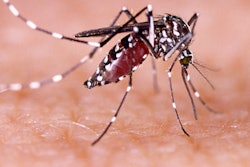
ORLANDO, FL - Much has been learned in the past year about the Zika virus and the damage it causes, but the big question now is whether a new outbreak will flare up in 2017, a key U.S. government official told attendees on Sunday at the American Institute of Ultrasound in Medicine (AIUM) annual meeting.
As the U.S. National Institutes of Health (NIH) continues to work on a variety of Zika countermeasures, including vaccines, it is also keeping an eye on whether the virus re-emerges as an epidemic in South America as well as in Puerto Rico, according to Dr. Anthony Fauci, director of the NIH's National Institute of Allergy and Infectious Diseases (NIAID).
"It is likely that we will see some infections [in 2017] and, in fact, almost impossible that we will not," he said. "But the real question is, will we have a true emergence of an outbreak, and will it then have the same impact in certain states of the continental U.S. like Florida and Texas? It's a race against time with developing a vaccine, but the immediate countermeasure will be as it was last year -- good mosquito control."
In a plenary presentation provided via a recorded video talk, Fauci reviewed the knowledge gained about the Zika virus since the outbreak began in Brazil in 2015, and he provided an update on efforts currently underway at the NIH to combat the virus.
Current status
As of March 2017, 61 countries/territories worldwide have active Zika virus transmission, Fauci said. Of these, 50 are in the Americas, including the Caribbean.
Fauci noted that the dangers of Zika became apparent when astute investigators in Brazil in 2015 and 2016 began noticing a sharp increase in the number of suspected and confirmed cases of microcephaly. However, researchers have discovered that microcephaly is unfortunately only the tip of the iceberg for Zika, he said.
In a study published in the December 15, 2016, edition of the New England Journal of Medicine that involved women in Rio de Janeiro, researchers reported that 42% of infants born to symptomatic Zika virus-infected mothers had grossly abnormal clinical and/or brain imaging results. This highlighted the higher chances of a deleterious effect on the fetus in mothers who had symptomatic Zika virus infection, he said.
Another important study published in the December 2, 2016, issue of Morbidity and Mortality Weekly Report described significant problems in Zika-infected babies who were born without microcephaly but then developed severe central nervous system abnormalities as their brain continued to develop after birth, Fauci said.
Early on in the epidemic, there was some initial concern that microcephaly was only being seen in Brazil and not in Colombia. That was just a misperception, he said. The birth cohort affected by Zika in Colombia was later than that of Brazil, and researchers eventually found marked increases in microcephaly in Colombia between January and November 2016.
Congenital Zika syndrome
With the benefit of a year's experience with the Zika outbreak, researchers have been able to characterize the pattern of congenital anomalies associated with infection, Fauci said. In a paper published online November 3, 2016, in JAMA Pediatrics, a team from the U.S. Centers for Disease Control and Prevention (CDC) defined congenital Zika syndrome as a recognizable pattern of a number of structural anomalies and functional disabilities secondary to central and perhaps peripheral nervous system damage.
The neonatal manifestations of congenital Zika virus infection include the following:
- Microcephaly
- Intracerebral calcifications (mostly periventricular)
- Hearing loss
- Vision abnormalities
- Lissencephaly
- Pachygyria
- Ventricular enlargement
- Arthrogryposis
- Muscular atrophy
Zika-related conditions are also being found in adults. A paper published October 20, 2016, in the New England Journal of Medicine noted the temporal coincidence of Zika infection and Guillain-Barre syndrome in a case series from seven countries. In a study published March 4, 2016, in the Lancet, a group reported a case of acute myelitis from Zika virus infection in a 15-year old girl in Guadeloupe, French West Indies. Another case study published in the March 9, 2016, edition of NEJM shared how an 81-year-old man in France developed meningoencephalitis associated with the Zika virus.
Transient hearing loss associated with Zika infection in adults was also described in a paper published December 7, 2016, in Clinical Infectious Diseases. In a study published March 18, 2017, in the Lancet, researchers reported cardiovascular manifestations such as myocarditis, heart failure, and arrhythmias that were clearly associated with Zika infection.
"That's the issue when you're dealing with a disease that you have little experience with, but then as you get more and more cases, you start to see manifestations that are not common, but are clearly there," Fauci said.
Zika in the U.S.
The U.S. has a high potential for imported cases of Zika; approximately 216 million passenger journeys take place each year to the U.S. from areas with local Zika virus transmission. Of these, 173 million are by land, 34 million are by air, and 9 million are by sea, he said.
According to CDC data as of March 15, there have been 5,139 Zika cases in the U.S.:
- 4,842 travel-associated cases
- 222 locally acquired mosquito-borne cases
- 45 sexually transmitted cases (all in Florida)
- 28 congenital cases
- 1 laboratory-acquired case
- 1 unknown case
The U.S. territories have 38,188 cases:
- 38,041 cases
- 147 travel-associated cases
"Puerto Rico got hit particularly hard," he said.
In 2016 and 2017, 221 cases of locally acquired, mosquito-borne Zika infection have been reported in Florida (215 cases) and Texas (6 cases). Many Aedes aegypti mosquitoes -- the primary vector of Zika virus infection -- are present in the coastal states such as Florida, and that led to significant concern last year about the possibility of an outbreak in these states, Fauci said.
There are many states that have these mosquitoes, "most obviously along the warmer Gulf Coast, but Aedes aegypti go up the East Coast to states within the Middle Atlantic states," Fauci said. An outbreak in the U.S. "is something we did not see [last year], and hopefully we will not see this in the next mosquito season."
Research and development
Fauci said the NIH has been involved in a number of research and development activities related to Zika, including performing basic and clinical research and working on countermeasures related to diagnostics, vaccines, therapeutics, and vector control. Five vaccine candidates are currently in development and are at various stages in the process, he said.
The first candidate is a DNA vaccine in which a gene of one of the Zika proteins is inserted into a DNA plasmid. Phase I testing began at the end of the summer and continued in a second phase I test in December, he said. In addition, a phase IIB randomized placebo-controlled trial is expected to get started by the end of March and will evaluate the safety and immunogenicity of the vaccine at more than 30 sites in the U.S., Caribbean, and Central and South America.
The NIH is also co-sponsoring the Zika in Infants and Pregnancy (ZIP) study along with the Oswaldo Cruz Foundation of Brazil. ZIP will be a prospective cohort study of 10,000 pregnant women who will be followed for incidence of Zika infection. Infants will be followed through at least 1 year of age to see if there are any Zika effects that might have been missed or if there are any harmful effects if infection occurs after birth, Fauci said.
He concluded his plenary talk by pointing out the perpetual challenge of dealing with infectious diseases.
"There always have been [infectious diseases] -- there are now, and there always will be," he said. "Zika is something that has captured our attention appropriately, but there will be more, as we know from history."




















